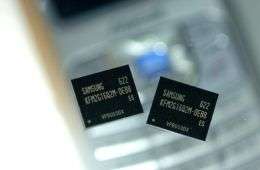Samsung Introduces Software to Increase Efficiency of Embedded Memory Solutions for Smart Phones

Samsung Electronics, the world leader in advanced semiconductor technology, announced today that it is introducing software designed to optimize the high performance features of its proprietary embedded flash memories: OneNAND, Flex-OneNAND and moviNAND, in smart phones, using the major mobile operating systems – Windows Mobile(CE), Symbian, Linux, and RTOS (real-time operating system).
"The new software, which significantly upgrades performance of our embedded memory solutions, is expected to make OneNAND and other high-performance, high-density memory solutions such as the 16GB moviNAND even more desirable for advanced handsets, speeding the adoption rate of Samsung’s embedded memory solutions," said Young Joon Choi, vice president, Memory Division, Samsung Electronics Co., Ltd.
Samsung's new software optimizes data transactions within its memory chips as they interact with the operating system. The new file system/flash driver combination, when working with any of the memory chips and the operating system, will boost performance through faster booting, downloading and searching. This results in improving multimedia intensive operations common in smart phones, 3rd generation phones, digital still cameras, digital camcorders, memory cards, and digital TVs.
Samsung's new embedded-flash software is comprised of several file systems and supportive flash drivers. The file systems – UniFS, PocketFS and RFS, execute typical file operations like creating, removing, reading, and writing files. The flash drivers – UniStore, PocketStore, XSR and FSR – prolong the CE device’s lifetime by wear-leveling and bad-block replacing, as well as converting file system requests into low level flash operations including programming, reading and erasing. Samsung provides a version of its new flash-optimized software for each of the major mobile operating systems.
The new embedded flash-optimized software is expected to shorten application design-in times and, as a result, broaden the adoption of advanced embedded-flash solutions, particularly where management of high-speed video images and high-resolution still images is important.
Samsung’s most popular advanced memory, OneNAND, is offered in a broad range of densities – 256 Megabit (Mb) through 2 Gigabit (Gb). Having achieved 100 million units of sales (512Mb-equivalent) in two years after initial shipments in 2006, Samsung expects its OneNAND business to exceed 500 million units by the end of this year.
The move to 60nm production technology last year and 50nm this year has reduced memory prices and accelerated OneNAND’s market acceptance, while increasing interest in Samsung’s newest embedded memory: Flex-OneNAND. Introduced earlier this year, Flex-OneNAND is a single-die solution with the high-speed characteristics of SLC (single level cell) NAND and the high-density of MLC (multi level cell) NAND.
MoviNAND, introduced in 2006, combines a MultiMediaCard v.4 (MMC) controller with NAND to simplify system design requirements for embedded non-volatile storage in data-intensive multimedia handsets.
Provided by Samsung





















